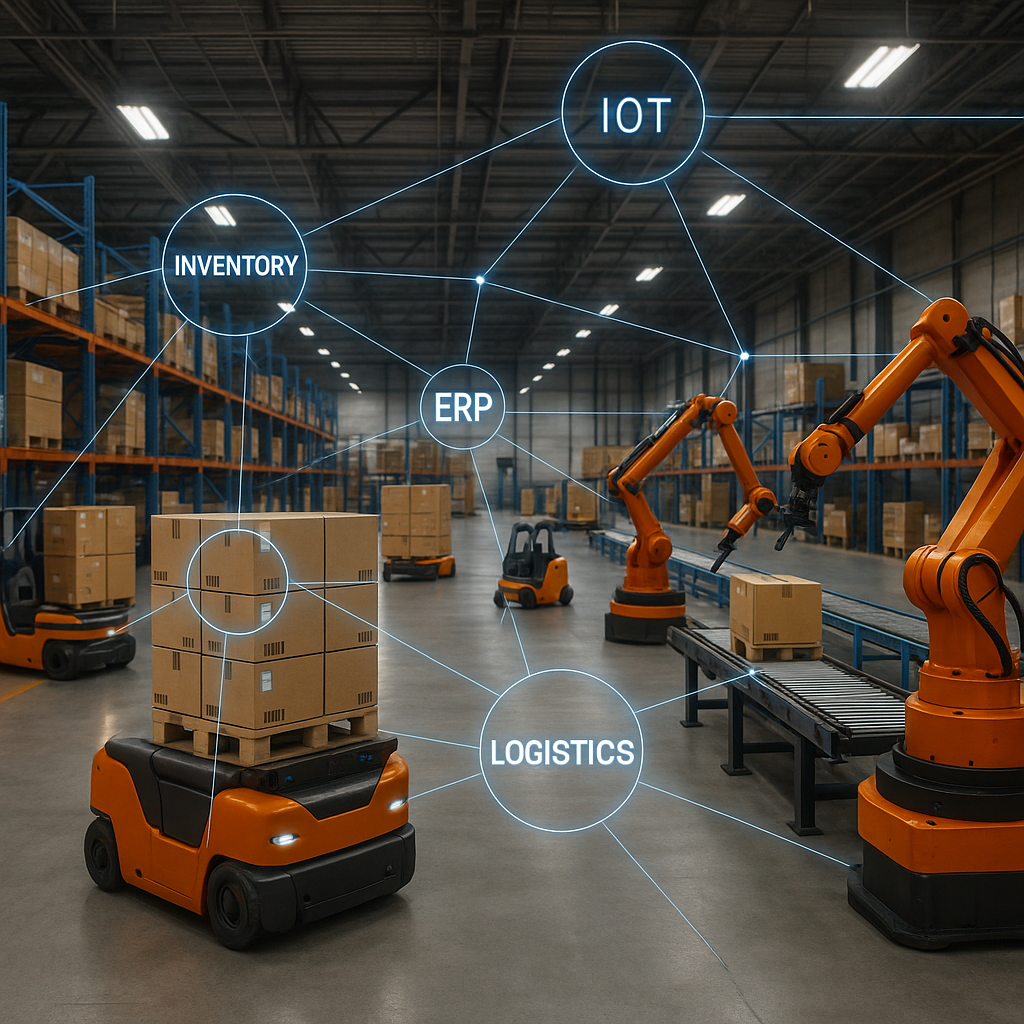IoT Integration with ERP Systems: Transforming Manufacturing Efficiency
The Industrial Internet of Things (IIoT) is no longer an experimental concept. As of August 2025, manufacturers that combine IoT technologies with...
6 min read
 Blake Snider
:
Aug 22, 2025 8:00:00 AM
Blake Snider
:
Aug 22, 2025 8:00:00 AM
Enterprise Resource Planning (ERP) systems have long been the backbone of manufacturing operations, streamlining workflows, managing supply chains, and tracking resources. But traditional ERP platforms often struggle with agility—they react to events rather than anticipate them.
As of August 2025, artificial intelligence (AI) and machine learning (ML) have transformed ERP into proactive, adaptive systems that help manufacturers forecast, automate, and innovate. For digital transformation leaders, the question is no longer if AI belongs in ERP, but how to leverage it for competitive advantage.
Manufacturers considering AI integration into ERP need a clear picture of what is driving urgency and where AI creates impact. Global supply chains remain unstable, customer expectations are rising, and production environments demand faster adaptation.
Traditional ERP falls short under these conditions, and manufacturers must understand how AI-powered ERP closes those gaps. The points below outline the pressures, limitations, advantages, and outcomes that set the stage for adoption.
AI integration delivers measurable outcomes across manufacturing operations. The following sections explore four critical areas where AI strengthens ERP: forecasting and supply chain management, predictive maintenance and quality control, intelligent scheduling, and automation with safety and compliance.
AI improves demand forecasting by analyzing sales trends, seasonal cycles, and external market signals with higher precision. It also optimizes inventory levels by learning from usage patterns and adjusting replenishment automatically. Advanced systems monitor supplier lead times and transportation costs, helping companies prevent shortages or surpluses. Together, these capabilities ensure production stays aligned with market demand while minimizing waste and costs.
ERP systems powered by AI monitor equipment in real time, identifying wear or irregularities before they cause failures. Predictive maintenance reduces downtime, cuts repair expenses, and extends machine life. At the same time, AI-powered computer vision inspects products on the line, detecting defects that human eyes might miss. These dual applications protect output quality while maintaining reliable operations.
AI-driven ERP generates dynamic production schedules that adapt instantly to machine downtime, rush orders, or material delays. The system evaluates staff availability and deadlines, creating efficient plans that minimize bottlenecks. Real-time analytics flag issues, simulate outcomes, and recommend corrective actions such as slowing one line or reallocating workers. This level of guidance shortens response times and supports consistent delivery performance.
Robotic Process Automation embedded in ERP eliminates repetitive tasks like order entry and invoice matching. AI enhances this by classifying data and triggering workflows, reducing errors and speeding operations. On the shop floor, AI sensors track environmental conditions and machine states, sending alerts when risks appear. Cobots handle dangerous tasks, while compliance checks are logged automatically—safeguarding workers and ensuring regulatory requirements are met.
Manufacturers demonstrate AI in ERP through real-world applications across supply chain optimization, predictive maintenance, automated assembly, and research-driven insights. Each case highlights how AI transforms ERP from a static record-keeping system into a dynamic tool that drives efficiency, reliability, and competitiveness in manufacturing.
LG Electronics uses AI-enhanced ERP to streamline global supply chains and reduce waste. By integrating AI into its smart factory operations, the company improves forecasting accuracy, balances production schedules, and adapts more effectively to global market shifts. The example of LG illustrates how AI-enabled ERP reduces inefficiencies while supporting sustainable manufacturing. (Source: LG Electronics press release)
Boeing applies predictive analytics within ERP systems to aircraft design and servicing. By analyzing sensor data and operational patterns, the company identifies potential failures before they occur, avoiding costly downtime and enhancing safety. Boeing’s use of AI-powered ERP highlights how predictive systems extend equipment life and ensure reliability in highly regulated industries. (Source: Boeing technical reports)
Samsung Electronics uses AI-driven ERP to automate assembly processes and strengthen quality control. Computer vision systems identify defects in real time, while ERP integrates the insights into production workflows. The approach ensures consistent product reliability at scale, reduces returns, and demonstrates how AI elevates ERP’s role in maintaining global competitiveness. (Source: Samsung AI research)
Many ERP vendors advertise “analytics,” but what they deliver often varies greatly. Basic analytics provide historical snapshots, while AI-embedded ERP systems deliver forward-looking intelligence. To highlight the difference, the table below compares how each approach impacts manufacturing operations:
| Aspect | Basic Analytics in ERP | AI-Embedded ERP |
|---|---|---|
| Insight Type | Reports what happened in the past | Explains why events occur and recommends next actions |
| Speed of Action | Slower, requires human interpretation | Faster insight-to-action cycles with automated alerts |
| Scalability | Limited in adapting to complex growth | Scales easily across plants, geographies, and operations |
| Technology Integration | Standalone dashboards | Integrated with IoT, robotics, sensors, and advanced analytics |
| Strategic Value | Descriptive, backward-looking | Predictive and prescriptive, shaping proactive strategies |
Manufacturers who adopt AI-powered ERP gain the ability to predict issues before they escalate, scale operations seamlessly, and integrate with advanced technologies. This distinction will determine which companies maintain competitiveness as AI adoption accelerates across the manufacturing sector.
Manufacturers adopting AI in ERP must approach it as a structured program, not a single technology add-on. Success depends on aligning data readiness, platform choices, workforce skills, and clear financial goals.
AI delivers reliable insights only when the data feeding it is accurate, complete, and current. Manufacturers need to unify siloed information from machines, supply chains, finance, and customer systems into a single data model. Establishing strong data governance and cleansing processes ensures AI algorithms can generate actionable intelligence instead of noise.
Legacy ERP systems may lack the APIs or processing power required for AI workloads. Leaders should conduct a technical audit to determine whether their systems can support AI extensions or whether a migration to cloud ERP is more effective. In many cases, hybrid approaches—layering AI tools onto existing platforms—provide a stepping stone toward full modernization.
AI in ERP changes how employees interact with technology and make decisions. Workers must learn to interpret predictive dashboards, validate machine learning recommendations, and adjust workflows based on AI alerts. Training programs, combined with strong leadership communication, help employees embrace the change rather than resist it. Companies that invest in upskilling see faster adoption and greater ROI from AI-enabled ERP.
Implementing AI requires upfront investment in software, infrastructure, and training resources. Manufacturers should quantify expected gains, such as reduced downtime hours, shorter production cycles, or higher yield rates, against these costs. Pilot projects are an effective way to validate value before scaling. Leaders who treat AI adoption as a staged, ROI-driven process achieve measurable improvements without overextending budgets.
As AI and ML mature, ERP platforms will evolve into adaptive “co-pilots” for manufacturers, integrating with technologies like IoT, digital twins, and generative AI.
According to McKinsey’s Industry 4.0 insights:
For leaders, the opportunity is clear: AI integration in ERP is becoming a baseline capability for manufacturers seeking long-term competitiveness. Companies that embed it today will define the competitive landscape tomorrow.
Astra Canyon has built a strong reputation for guiding manufacturers through complex ERP transformations, with a growing focus on embedding AI, machine learning, and RPA into ERP environments. With more than two decades of industry experience and hundreds of ERP projects delivered, our consultants understand both the technology and the realities of plant-floor operations.
Manufacturers such as Kodiak, PowerSecure, Barnhart, ESG, and HCR have partnered with Astra Canyon to modernize ERP systems and unlock new value from AI integration. A recent example is Nomad Global Communication Solutions, where our team replaced legacy systems with an intelligent ERP platform, aligning manufacturing and field services while meeting Department of Defense compliance. These projects demonstrate how AI-enabled ERP is already helping manufacturers compete smarter.
Curious about which ERP platforms best support AI integration? Explore our guide to the top ERP systems for manufacturing. Ready to explore the next step? Sign up for an AI-powered ERP roadmap session and see how your operations can accelerate.

The Industrial Internet of Things (IIoT) is no longer an experimental concept. As of August 2025, manufacturers that combine IoT technologies with...

Are you confident your ERP system can keep pace with what’s coming? Manufacturers are already rethinking what ERP should do, moving beyond...
Which ERP features should a manufacturing business prioritize to run on time and on budget?